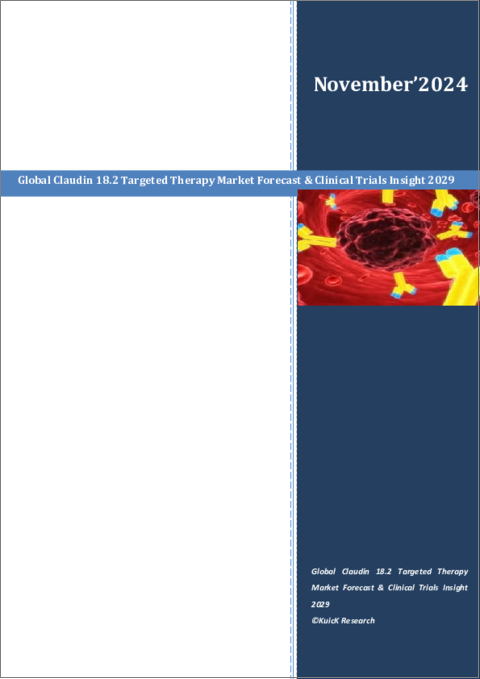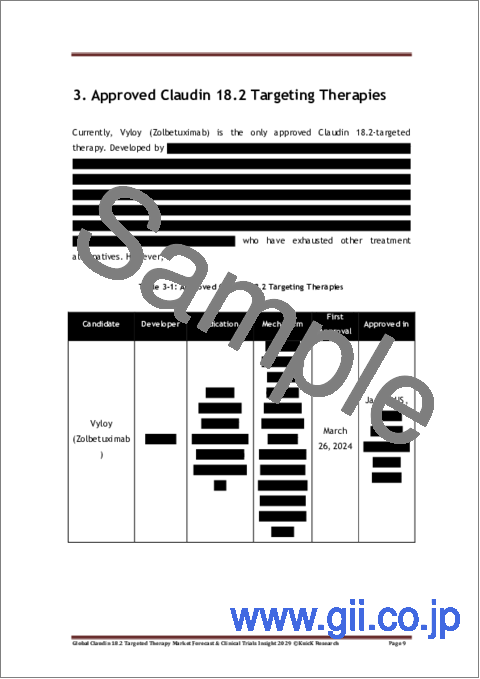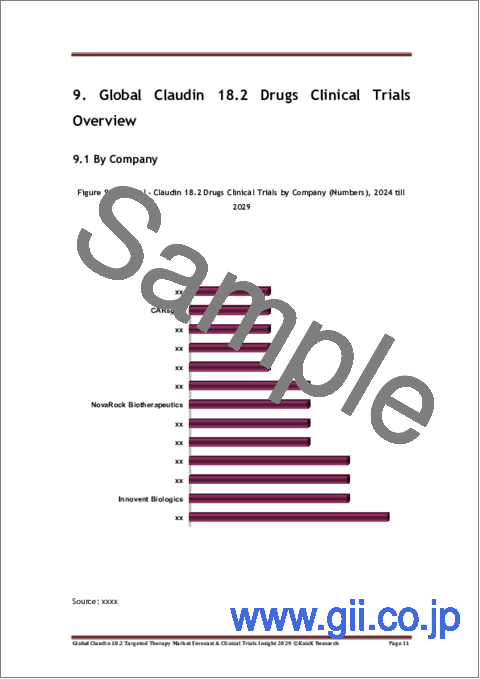|
|
市場調査レポート
商品コード
1593543
クローディン18.2標的療法の世界市場:市場予測と臨床試験動向(2029年)Global Claudin 18.2 Targeted Therapy Market Forecast & Clinical Trials Insight 2029 |
||||||
|
|||||||
| クローディン18.2標的療法の世界市場:市場予測と臨床試験動向(2029年) |
|
出版日: 2024年11月01日
発行: KuicK Research
ページ情報: 英文 240 Pages
納期: 即日から翌営業日
|
- 全表示
- 概要
- 図表
- 目次
クローディン18.2(CLDN18.2)は、タイトジャンクションタンパク質ファミリーのメンバーであるクローディン18のアイソフォームです。正常組織での発現は限定的ですが、胃がん、胃食道接合部がん、卵巣がん、その他の固形がんを含む様々な原発性悪性腫瘍ではしばしば異常発現を示します。この発見は、胃がんを中心とするこれらのがんを治療するために、クローディン18.2を阻害することを目的とした標的療法の開発につながっています。2024年11月現在、このような治療薬が1つ承認されており、他にもいくつかの治療薬が開発段階にあります。世界中の製薬会社がこの有望な分野に多額の投資を行っており、その治療法は様々な薬剤クラスに及んでいます。これらの努力は、クローディン18.2を標的とした治療が胃がんの治療状況を一変させる可能性を強調するものであり、この研究分野を今後数年間注視すべき分野にしています。
2024年3月に承認されたVyloy(ゾルベツキシマブ)は、クローディン18.2を標的とする最初の薬剤であり、この分野で重要なマイルストーンとなっています。Ganymed Pharmaceuticalsが開発し、後にAstellas Pharmaが買収したVyloyは、米国、EU、日本などの主要国で、腫瘍がクローディン18.2を発現しているHER2陰性のG/GEJ腺がん患者の第一選択薬として、化学療法との併用ですでに承認されています。さらに、2024年末までに中国で承認される見込みであることから、この治療法の世界の拡大が示唆され、これらの侵攻性腫瘍に対する重要な治療選択肢として確立されることになります。
米国におけるVyloyの販売データは、同療法の強力な普及を示しており、2024年第3四半期末には売上高が700万米ドルを突破する見込みです。この市場浸透の拡大は、この領域における有効な治療に対するアンメットニーズと、クローディン18.2の標的としての強い治療可能性の両方を示しています。ゾルベツキシマブは現在臨床開発段階にあり、様々な治療レジメンとの併用や、膵臓がんなどG/GEJ腺がん以外の腫瘍への応用の可能性を検討しています。これらの拡大は、クローディン18.2を標的とする医薬品のスペクトラムとインパクトを拡大する可能性があります。
Vyloy以外にも、モノクローナル抗体、二重特異性抗体、CAR-T細胞療法、抗体薬物複合体(ADC)など、多数のクローディン18.2標的薬が開発中です。これらの候補のうち5つはすでに第3相臨床試験段階にあり、そのほとんどがG/GEJ悪性腫瘍を対象としているが、卵巣がんや肺がんなど他の腫瘍型でも有望な研究結果が得られています。このような治療選択肢の多様なパイプラインは、腫瘍学におけるクローディン18.2標的への関心の高まりと可能性を強調しています。
今後、クローディン18.2標的治療薬市場は、現在の治療薬の有望な成績とパイプラインの成長により、さらに拡大すると予想されます。G/GEJ悪性腫瘍が依然として主要な焦点である一方、その他の適応症の調査により、これらの治療法の用途が広がる可能性があります。市場は世界な性格を持ち、欧米企業とアジア企業の両方が参入しているため、協力的かつ競合的な雰囲気が醸成され、さらなる技術革新が促進される可能性が高いです。より多くの治療法が開発・承認され、コンパニオン診断薬がより広く利用されるようになれば、クローディン18.2標的治療ががん治療に与える影響は大きく拡大し、治療が困難ながん患者に新たな希望を提供することが期待されます。
当レポートは、世界のクローディン18.2標的療法市場について調査し、市場の概要とともに、薬剤動向、臨床試験動向、地域別動向、および市場に参入する企業の競合情勢などを提供しています。
目次
第1章 クローディン18.2療法のイントロダクション
第2章 がん免疫療法におけるクローディン18.2を標的とした調査の進展
- モノクローナル抗体
- 二重特異性抗体
- CAR T細胞療法
- 抗体薬物複合体
第3章 承認済みクローディン18.2標的療法
第4章 Vyloy-最初に承認されたクローディン18.2標的療法
第5章 世界のクローディン18.2市場シナリオ
第6章 クローディン18.2療法の動向分析、地域別
- 米国
- 中国
- 欧州
- 英国
- 日本
- オーストラリア
- 韓国
第7章 クローディン18.2療法の臨床動向とイノベーション、適応症別
- 胃がん
- 膵臓がん
- 卵巣がん
- 肺がん
第8章 高度なクローディン18.2療法を開発するための技術的および臨床的プラットフォーム
第9章 世界のクローディン18.2医薬品臨床試験の概要
- 企業別
- 国別
- 適応症別
- 患者セグメント別
- 相別
第10章 企業、適応症、相別の世界のクローディン18.2医薬品臨床試験
- 研究
- 前臨床
- 第0相
- 第I相
- 第I/II相
- 第II相
- 第III相
第11章 上市済みクローディン18.2薬剤の臨床的洞察
第12章 競合情勢
- Abpro Therapeutics
- Antengene Corporation
- Arovella Therapeutics
- Astellas Pharma
- AstraZeneca
- Beijing Mabworks Biotech
- Biotheus
- CARsgen
- Dragonboat Biopharmaceutical
- Gracell Biotechnology
- Harbour BioMed
- Innovent Biologics
- Klus Pharma
- L and L Biopharma
- LaNova Medicines Limited
- Leap Therapeutics
- Luye Pharma Group
- Nanjing Bioheng Biotech
- Nanjing KAEDI Biotech
- OriCell Therapeutics
- Shanghai Junshi Biosciences
- SparX Biopharmaceutical
- TORL Biotherapeutics
- Transcenta Holding
List of Figures
- Figure 1-1: Claudin 18.2 Protein - Functions
- Figure 1-2: Functional Classification of the Claudin Family Proteins
- Figure 1-3: Dichotomous Role of Claudin 18.2 Protein in Cancer
- Figure 1-4: Claudin 18 Isoforms
- Figure 1-5: Global - Gastric Cancer Incidences & Deaths (Million), 2022
- Figure 2-1: Therapeutic Approach for Claudin 18.2 protein
- Figure 2-2: Monoclonal Antibody - Mode of Action
- Figure 2-3: Claudin 18.2 - Novel Monoclonal Antibodies in Clinical Research
- Figure 2-4: Bispecific Antibody - Advantages
- Figure 2-5: PT886 - Phanes Therapeutics Development Vista
- Figure 2-6: QLS31905 Phase 1/2 Study - Initiation & Completion Year
- Figure 2-7: ASP2138 - Astellas Pharma
- Figure 2-8: CARsgen Pharmaceuticals Collaboration - Fudan & Peking University for CT041 & CT048
- Figure 2-9: Immunofoco - Pipeline for Claudin 18.2 Therapy
- Figure 2-10: NCT06084286 Phase 1 Study - Initiation & Completion Year
- Figure 2-11: Claudin 18.2 - ADC Candidates
- Figure 2-12: SKB315 - Clinical Trial & Collaboration Overview
- Figure 4-1: Vyloy - Approval Year by Region
- Figure 4-2: Global - Annual Vyloy Sales (US$ Million), 2024
- Figure 4-3: Global - Quarterly Vyloy Sales (US$ Million), Q2-Q3'2024
- Figure 5-1: Current Claudin 18.2 Therapy Market - Influencing Factors
- Figure 5-2: Global - Claudin 18.2 Targeted Therapy Market, (US$ Million), 2024
- Figure 5-3: Global - Claudin 18.2 Targeted Therapy Market, (US$ Million), Q2-Q3'2024
- Figure 5-4: Market Drivers for Claudin 18.2 Therapy
- Figure 5-5: Market Challenges for Claudin 18.2 Therapy
- Figure 5-6: Global - Claudin18.2 Targeted Therapies Market (US$ Million), 2024 - 2029
- Figure 5-7: Future Claudin 18.2 Therapy Market - Influencing Factors
- Figure 6-1: Triumvira Immunologics - Pipeline for Claudin 18.2 Therapies
- Figure 6-2: US - Factors Influencing Claudin 18.2 Therapy Development
- Figure 6-3: China - Major Candidates in Clinical Trial
- Figure 6-4: LM-302 Phase 2 Study - Initiation & Completion Year
- Figure 6-5: TQB2103 Phase 1 Study - Initiation & Completion Year
- Figure 6-6: CT048 Phase 1 Study - Initiation & Completion Year
- Figure 6-7: SOT102 Phase 1/2 Study - Initiation & Completion Year
- Figure 6-8: AZD0901 Phase 2 Study - Initiation & Completion Year
- Figure 6-9: AZD5863 Phase 1/2 Study - Initiation & Completion Year
- Figure 6-10: SPOTLIGHT Phase 3 Study - Initiation & Completion Year
- Figure 6-11: GLOW Phase 3 Study - Initiation & Completion Year
- Figure 6-12: ATG-022 Phase 1 Study - Initiation & Completion Year
- Figure 7-1: Claudin 18.2 - Upregulation in Gastric Cancer
- Figure 7-2: HEC-016 Phase 1 Study - Initiation & Completion Year
- Figure 7-3: TJ-CD4B - Structure & Mode of Action
- Figure 7-4: Osemitamab Phase 1/2 Study - Initiation & Completion Year
- Figure 7-5: SOT102 Phase 1/2 Study - Initiation & Completion Year
- Figure 7-6: KD-496 Early Phase 1 Study - Initiation & Completion Year
- Figure 7-7: Zolbetuximab Phase 2 Study - Initiation & Completion Year
- Figure 7-8: IMC002 Phase 1 Study - Initiation & Completion Year
- Figure 7-9: TAC01-CLDN18.2 Phase 1/2 Study - Initiation & Completion Year
- Figure 7-10: ZZCART-002 Phase 1 Study - Initiation & Completion Year
- Figure 8-1: CARsgen Pharmaceuticals - CycloCAR platform
- Figure 8-2: LaNova - LX-ADC(TM) Platform
- Figure 8-3: Phanes Therapeutics - PACbody
- Figure 8-4: Phanes Therapeutics - SPECpair
- Figure 9-1: Global - Claudin 18.2 Drugs Clinical Trials by Company (Numbers), 2024 till 2029
- Figure 9-2: Global - Claudin 18.2 Drugs Clinical Trials by Country (Numbers), 2024 till 2029
- Figure 9-3: Global - Claudin 18.2 Drugs Clinical Trials by Indication (Numbers), 2024 till 2029
- Figure 9-4: Global - Claudin 18.2 Drugs Clinical Trials by Patient Segment (Numbers), 2024 till 2029
- Figure 9-5: Global - Claudin 18.2 Drugs Clinical Trials by Phase (Numbers), 2024 till 2029
List of Tables
- Table 1-1: Subfamilies of Claudin involved in Different Types of Cancer Formation
- Table 2-1: Monoclonal Antibodies Targeting Claudin 18.2 in Clinical Trials
- Table 2-2: Bispecific Antibodies Targeting Claudin 18.2 in Clinical Trials
- Table 2-3: CAR-T Therapies Targeting Claudin 18.2 in Clinical Trials
- Table 2-4: Antibody Drug Conjugates Targeting Claudin 18.2 in Clinical Trials
- Table 3-1: Approved Claudin 18.2 Targeting Therapies
- Table 4-1: Vyloy - Recommended Dose Modifications in case of Adverse Reactions
- Table 5-1: Claudin18.2 Targeting Therapies in Phase 3
- Table 6-1: US - Claudin 18.2 Therapies in Ongoing Clinical Trials
- Table 6-2: China - Claudin 18.2 Therapies in Ongoing Clinical Trials
- Table 6-3: EU - Claudin 18.2 Therapies in Ongoing Clinical Trials
- Table 6-4: UK - Claudin 18.2 Therapies in Ongoing Clinical Trials
- Table 6-5: Japan - Claudin 18.2 Therapies in Ongoing Clinical Trials
- Table 6-6: Australia - Claudin 18.2 Therapies in Ongoing Clinical Trials
Table 6 7: South Korea - Claudin 18.2 Therapies in Ongoing Clinical Trials
- Table 7-1: Gastric Cancer - Claudin 18.2 Therapies in Ongoing Clinical Trials
- Table 7-2: Pancreatic Cancer - Claudin 18.2 Therapies in Ongoing Clinical Trials
Global Claudin 18.2 Targeted Therapy Market Forecast & Clinical Trials Insight 2029 Report Highlights:
- Global & Regional Market Trends Insight
- Currently Only 1 Claudin 18.2 Targeted Drug Is Approved: Vyloy (zolbetuximab)
- Approved Drug Dosage, Pricing & Sales Insight
- Claudin 18.2 Therapy Clinical Trends & Innovations by Indication
- Number Claudin 18.2 Drugs In Clinical Trials: > 60 Drugs
- Global Claudin 18.2 Drugs Clinical Trials By Company, Indication & Phase
- Insight On Technical & Clinical Platforms For Developing Advanced Claudin 18.2 Therapy
Claudin18.2 (CLDN18.2) is an isoform of Claudin18, a member of the tight junction protein family. It serves as a highly selective biomarker, exhibiting limited expression in normal tissues but often showing abnormal expression in various primary malignancies, including gastric cancer, gastroesophageal junction cancer, ovarian cancer, and a few other solid tumors. This finding has led to the development of targeted therapies aimed at inhibiting Claudin18.2 for treating these cancers, majorly gastric cancers. As of November 2024, one such therapy has been approved, with several others in advanced stages of development. Pharmaceutical companies around the world are investing heavily in this promising field, with treatments spanning a range of drug classes. These efforts underscore the potential of Claudin18.2-targeted therapies to transform the treatment landscape for gastric cancer, making this area of research one to watch closely in the coming years.
The approval of Vyloy (zolbetuximab) in March 2024 marked a significant milestone in the field, as it is the first medication to target Claudin18.2. Vyloy, developed by Ganymed Pharmaceuticals and later acquired by Astellas Pharma, has already been approved in major countries, such as the US, the EU, and Japan, for use in combination with chemotherapy as the first-line treatment of patients with HER2-negative G/GEJ adenocarcinoma whose tumors express Claudin18.2. Additionally, the anticipated approval in China by the end of 2024 suggests a global expansion of this therapy, establishing it as a crucial treatment option for these aggressive tumors.
Sales data for Vyloy has indicated a strong adoption, with the therapy's sales surpassing US$ 7 Million by the end of the third quarter of 2024. This increasing market penetration demonstrates both the unmet need for effective treatments in this domain and Claudin18.2's strong therapeutic potential as a target. Zolbetuximab is now in clinical development, with trials investigating its application in combination with various therapy regimens as well as potential applications in tumors other than G/GEJ adenocarcinoma, such as pancreatic carcinoma. These expansions may extend the spectrum and impact of Claudin18.2-targeted medicines.
Aside from Vyloy, numerous other Claudin18.2-targeting medicines are under development, including monoclonal antibodies, bispecific antibodies, CAR-T cell therapies, and antibody-drug conjugates (ADCs). Five of these candidates are already in phase 3 clinical trials, largely for G/GEJ malignancies, but research is showing promise in other tumor types, including as ovarian and lung cancers. This varied pipeline of treatment options highlights the increased interest and potential for targeting Claudin18.2 in oncology.
The competitive landscape for Claudin18.2-targeting therapies is becoming more dynamic, with major corporations investing in research and development. China, in particular, has emerged as a hub of innovation in this field, with numerous companies, including Innovent, MabWorks, and Biotheus, making substantial progress in developing Claudin18.2-targeting medicines.
Companion diagnostic tests are an important element of the Claudin18.2-targeting therapeutic industry. Roche Diagnostics developed the Ventana(R) CLDN18 (43-14A) RxDx Assay, the first immunohistochemistry-based test approved to detect Claudin18.2 expression in patients with G/GEJ adenocarcinoma. This test identifies which patients are most likely to benefit from Vyloy treatment, resulting in more precise and successful therapy selection. As the market for Claudin18.2-targeted therapies grows, the development and implementation of companion diagnostics will be critical in improving treatment results.
Looking ahead, the Claudin18.2-targeting therapy market is expected to increase further, owing to the encouraging results of current medications and a growing pipeline. While G/GEJ malignancies remain the primary focus, research into additional indications may broaden the uses of these therapies. The market's global nature, with strong representation from both Western and Asian enterprises, creates a collaborative and competitive atmosphere that is likely to encourage further innovation. As more therapies are developed and approved, and as companion diagnostics become more widely available, the impact of Claudin18.2-targeted therapies on cancer treatment is expected to grow significantly, offering new hope for patients with difficult-to-treat cancers.
Table of Contents
1. Introduction To Claudin 18.2 Therapy
- 1.1 Understanding Claudin 18.2 Proteins
- 1.2 Development Of Claudin 18.2 Therapy
- 1.3 Need For Claudin 18.2 Targeted Therapy
2. Research Advancement Targeting Claudin 18.2 For Cancer Immunotherapy
- 2.1 Monoclonal Antibody
- 2.2 Bispecific Antibody
- 2.3 CAR T Cell Therapy
- 2.4 Antibody Drug Conjugate
3. Approved Claudin 18.2 Targeting Therapies
4. Vyloy - 1st Approved Claudin 18.2 Targeted Therapy
- 4.1 Clinical Insight
- 4.2 Pricing & Dosing Insight
- 4.3 Sales Insight
5. Global Claudin 18.2 Market Scenario
- 5.1 Current Market Overview
- 5.2 Favorable Market Development Parameters
- 5.3 Key Developmental Challenges
- 5.4 Future Market Outlook
6. Claudin 18.2 Therapy Trend Analysis By Region
- 6.1 US
- 6.2 China
- 6.3 Europe
- 6.4 UK
- 6.5 Japan
- 6.6 Australia
- 6.7 South Korea
7. Claudin 18.2 Therapy Clinical Trends & Innovations by Indication
- 7.1 Gastric Cancer
- 7.2 Pancreatic Cancer
- 7.3 Ovarian Cancer
- 7.4 Lung Cancer
8. Technical & Clinical Platforms For Developing Advanced Claudin 18.2 Therapy
9. Global Claudin 18.2 Drugs Clinical Trials Overview
- 9.1 By Company
- 9.2 By Country
- 9.3 By Indication
- 9.4 By Patient Segment
- 9.5 By Phase
10. Global Claudin 18.2 Drugs Clinical Trials By Company, Indication & Phase
- 10.1 Research
- 10.2 Preclinical
- 10.3 Phase 0
- 10.4 Phase I
- 10.5 Phase I/II
- 10.6 Phase II
- 10.7 Phase III
11. Marketed Claudin 18.2 Drugs Clinical Insight
12. Competitive Landscape
- 12.1 Abpro Therapeutics
- 12.2 Antengene Corporation
- 12.3 Arovella Therapeutics
- 12.4 Astellas Pharma
- 12.5 AstraZeneca
- 12.6 Beijing Mabworks Biotech
- 12.7 Biotheus
- 12.8 CARsgen
- 12.9 Dragonboat Biopharmaceutical
- 12.10 Gracell Biotechnology
- 12.11 Harbour BioMed
- 12.12 Innovent Biologics
- 12.13 Klus Pharma
- 12.14 L and L Biopharma
- 12.15 LaNova Medicines Limited
- 12.16 Leap Therapeutics
- 12.17 Luye Pharma Group
- 12.18 Nanjing Bioheng Biotech
- 12.19 Nanjing KAEDI Biotech
- 12.20 OriCell Therapeutics
- 12.21 Shanghai Junshi Biosciences
- 12.22 SparX Biopharmaceutical
- 12.23 TORL Biotherapeutics
- 12.24 Transcenta Holding






